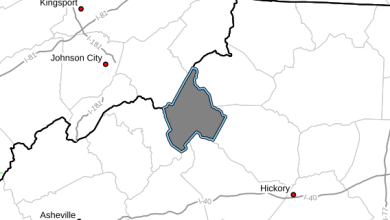Last Updated on July 11, 2018 2:02 pm
Hogweed, a biennial plant in the carrot family, is making recent headlines both nationally and regionally but many may not know that is growing in a section of Watauga County.
Giant hogweed is a threat to natural systems and human health, according to the North Carolina Department of Agriculture and Consumer Services. In listing the hazards of the plant NCDA&CS notes, “It is an aggressive plant that can dominate ravines and stream banks due to its size and rapid growth, reducing the amount of suitable habitat for natural plants and wildlife. When it dies off during winter months, increased soil erosion can happen.”
A recent television report noted the plant was known to grow in Watauga County. WataugaOnline.com reached out recently to Watauga County Extension Director Dr. Jim Hamilton for more information. Dr. Hamilton responded, “We do have (or at least did have) some giant hogweed here in Watauga County. I went out with Chad Taylor, NCDA Plant Inspector, a couple years ago to see it. He's been involved in eradicating it when reported/identified. The ones he showed me were in the Blowing Rock area off 221 and I think a few closer in to town.”
Hamilton also noted, “There IS another very similar plant that we've been called out to identify to make sure it wasn't giant hogweed. ‘Cow parsnip' looks very similar and can also cause allergic reactions. Not as bad as hogweed, but the species look similar.”
The hogweed plant, which can can grow up to 15 feet tall, produces dried fruits which birds eat, thus dispersing the seeds. Giant Hogweed is a Federal Noxious Weed, as well as a Class A North Carolina Noxious Weed, and is found only in Watauga County, according to NCDA&CS. It was introduced by a homeowner for soil erosion, and shared with neighbors. The plant was discovered in 2010, and has been found in 6 unique sites around Blowing Rock. The sap of the plant is very dangerous when it gets on your skin or in your eyes, causing blisters and blindness, according to NCDA&CS.
In a Facebook post this week the Watauga Extension posted photos of a recent find between Boone and Valle Crucis. In the post they noted, “Several calls about giant hogweed after recent news media releases. Here are some pictures from Watauga. NCDA Plant Inspector/Supervisor, Chad Taylor, came out to confirm a sighting between Boone and Valle Crucis. Chad has been working on eradication of this noxious and toxic weed. Thanks, Julia Ebel, for the tip/location. Giant hogweed is similar to cow parsnip. However, note overall size of plant, large size of leaves and flower head, and purplish ‘stains/streaks' on the stem. Give us a call at the Extension office if you have questions.”
Along with Watauga County, Giant Hogweed has been found in Pennsylvania, Maryland, Connecticut, Washington DC, Maine, Massachusetts, Wisconsin, Michigan, NY, Indiana, Illinois, Oregon, Washington and most recently in Virginia.
On a national level the plant has received news coverage from The New York Times, CBS News, and WebMD to name a few.
Photos: Watauga Extension Facebook.
























